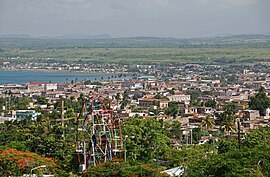Matanzas
| Matanzas | |
|---|---|
|
Coordinates: 23 ° 3 ′ N , 81 ° 35 ′ W
Matanzas on the map of Cuba
|
|
| Basic data | |
| Country | Cuba |
| province | Matanzas |
| City foundation | 1693 |
| Residents | 151,624 (2012) |
| Detailed data | |
| surface | 317 km 2 |
| Population density | 408.8 inhabitants / km 2 |
| height | 3 m |
| prefix | + 53-52 |
| Time zone | UTC -5 |
| View of Matanzas | |
Matanzas is the capital of the province of the same name in Cuba with 151,624 inhabitants (2012 census).
geography
The city is only 3 m above sea level, 102 km east of Havana , 40 km west of Varadero and 833 km west of Santiago de Cuba between the Yumuri and San Juan rivers in northwest Cuba.
history
In 1693 the city was founded. The name Matanzas means something like "slaughter" or "slaughter" and stands for the slaughter that was carried out at the port . It is the only port where cattle used to be exported. Another theory says that the name of the city derives from the time of the armed conflicts between natives and immigrants.
Matanzas was an important hub for slaves , tobacco, coffee and sugar cane. In the 19th century , Matanzas became the sugar capital with more than half of Cuba's total production. In 19th century Cuba, the city developed at a breathtaking rate due to the export of sugar and other products to the United States. This bloom was due to the fact that there was a beautiful, useful bay, an extensive, fertile valley and important sugar cane plantations were close by. This economic development created a cultural climate that attracted intellectuals, writers and musicians and gave the city the name "the Athens of Cuba". Matanzas is the birthplace of the Cuban dances "Danzon" and "Danzonete".
Nowadays Matanzas is primarily (similar to the city of Cárdenas) the residence of the Cubans employed in the tourist resort of Varadero . Matanzas is the location of one of the large power plants (guiteras) that supply Cuba with electricity. The city continues to live from the sugar loading, the power plant, a fertilizer factory and a cement plant. The plan is to build an oil refinery that will process 150,000 barrels of oil a day .
Attractions
- The Pharmaceutical Museum at Freedom Park, Avenida Milanes: was founded in 1882 by the doctor Ernesto Triolet. After the revolution of 1959 the pharmacy had to close and it has been a museum ever since. Antique porcelain bottles from France and old glass containers from Bohemia fill the shelves. With the help of mortars, old glass bottles, porcelain bowls, stills and medical instruments, the pharmaceutical production of the time can be traced.
More Attractions:
- Bellamar cave (stalactite cave)
- Bridges of Matanzas
- Art gallery in the headquarters of the Poder Popular (Calle Ayuntamiento)
- Sauto Theater on Matanzas Bay
- Castillo de San Severino (in the north of the city)
- Historical Museum at the Freedom Park
- Hershey Railway Cuba's only electric railway line to Havana
- Acuaducto de Matanza , built by the German engineer F. Heydrich in 1870
education
The Universidad de Matanzas "Camilo Cienfuegos" is located in the city .
sons and daughters of the town
- Agustín Acosta (1886–1978), politician and writer
- Andrés Aldama (* 1956), Olympic champion in boxing
- Louis Oscar Amoëdo y Valdes (1863–1945), doctor and dentist, founder of modern forensic dentistry
- Fernando Heydrich Klein (1827–1903), builder of the Matanza aqueduct
- Omar Rodriguez Calvo (* 1973), jazz musician
- Rafael Bienvenido Cruz (* 1939), American mathematician, physicist and pastor, father of Ted Cruz
- Lisandra Guerra (* 1987), track cyclist and world champion
- Joel Isasi (* 1967), sprinter
- Ricardo Izquierdo (* 1978), jazz musician
- Yosvany Sánchez Larrudet (* 1975), wrestler and Olympian
- Odaline de la Martinez (* 1949), composer and conductor
- Rogelio Martínez Díaz (1905–2001), guitarist, singer and director of the Sonora Matancera
- Pérez Prado (1916–1989), musician and composer
- Sugar Ramos (1941-2017), boxer
- Angel Reyes (1889–1988), composer and violinist
- Willy "El Baby" Rodríguez (* 1941), singer
- Hilda Elvira Santiago (* 1947), pianist, composer, choir director and music teacher
- José White Lafitte (1836–1918), violinist and composer
- Lyen Wong (* 1974), German-Cuban fitness athlete
Individual evidence
- ↑ ONE, 2012 census (PDF; 257 kB)
- ↑ $ 2 billion trade deal. In: Venezuela current. Red Globe, December 14, 2008, accessed December 15, 2008 .
- ^ Jorge Méndez Rodríguez-Arencibia: Cuba y Alemania, más vínculos que distancias. Excelencias Magazines, 2016, accessed July 5, 2017 (esp).
Web links
- La Ciudad de Matanzas at guije.com (Spanish)






